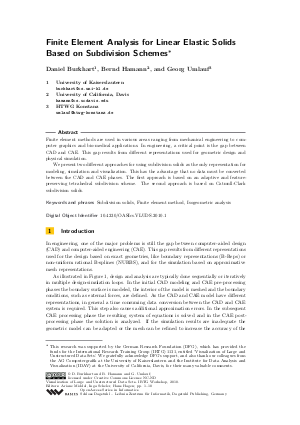Finite Element Analysis for Linear Elastic Solids Based on Subdivision Schemes
Authors Daniel Burkhart, Bernd Hamann, Georg Umlauf
-
Part of:
Volume:
Visualization of Large and Unstructured Data Sets - Applications in Geospatial Planning, Modeling and Engineering (IRTG 1131 Workshop) (VLUDS 2010)
Part of: Series: Open Access Series in Informatics (OASIcs) - License:
 Creative Commons Attribution-NonCommercial-NoDerivs 3.0 Unported license
Creative Commons Attribution-NonCommercial-NoDerivs 3.0 Unported license
- Publication Date: 2011-04-13
File

PDF
OASIcs.VLUDS.2010.1.pdf
- Filesize: 2.67 MB
- 10 pages
Document Identifiers
Subject Classification
Keywords
- Subdivision solids
- Finite element method
- Isogeometric analysis
Metrics
- Access Statistics
-
Total Accesses (updated on a weekly basis)
0PDF Downloads0Metadata Views
Abstract
Finite element methods are used in various areas ranging from mechanical engineering to computer graphics and bio-medical applications. In engineering, a critical point is the gap between CAD and CAE. This gap results from different representations used for geometric design and physical simulation. We present two different approaches for using subdivision solids as the only representation for modeling, simulation and visualization. This has the advantage that no data must be converted between the CAD and CAE phases. The first approach is based on an adaptive and feature-preserving tetrahedral subdivision scheme. The second approach is based on Catmull-Clark subdivision solids.
Cite As Get BibTex
Daniel Burkhart, Bernd Hamann, and Georg Umlauf. Finite Element Analysis for Linear Elastic Solids Based on Subdivision Schemes. In Visualization of Large and Unstructured Data Sets - Applications in Geospatial Planning, Modeling and Engineering (IRTG 1131 Workshop). Open Access Series in Informatics (OASIcs), Volume 19, pp. 1-10, Schloss Dagstuhl – Leibniz-Zentrum für Informatik (2011)
https://doi.org/10.4230/OASIcs.VLUDS.2010.1
BibTex
@InProceedings{burkhart_et_al:OASIcs.VLUDS.2010.1,
author = {Burkhart, Daniel and Hamann, Bernd and Umlauf, Georg},
title = {{Finite Element Analysis for Linear Elastic Solids Based on Subdivision Schemes}},
booktitle = {Visualization of Large and Unstructured Data Sets - Applications in Geospatial Planning, Modeling and Engineering (IRTG 1131 Workshop)},
pages = {1--10},
series = {Open Access Series in Informatics (OASIcs)},
ISBN = {978-3-939897-29-3},
ISSN = {2190-6807},
year = {2011},
volume = {19},
editor = {Middel, Ariane and Scheler, Inga and Hagen, Hans},
publisher = {Schloss Dagstuhl -- Leibniz-Zentrum f{\"u}r Informatik},
address = {Dagstuhl, Germany},
URL = {https://drops.dagstuhl.de/entities/document/10.4230/OASIcs.VLUDS.2010.1},
URN = {urn:nbn:de:0030-drops-30928},
doi = {10.4230/OASIcs.VLUDS.2010.1},
annote = {Keywords: Subdivision solids, Finite element method, Isogeometric analysis}
}
